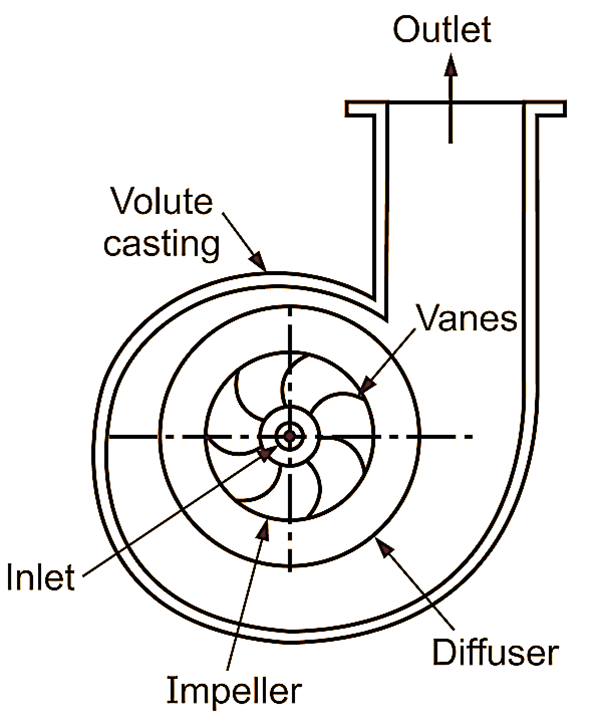The centrifugal compressor increases the pressure of low pressure vapour refrigerant by first creating a very high velocity and hence, kinetic energy and then converting a part of this kinetic energy of moving particles into high static pressure by centrifugal force.

Fig. 1: Centrifugal compressor.
Construction and Working of Centrifugal Compressor
A single stage centrifugal compressor consists of an impeller, to which, a number of curved vanes are fitted symmetrically, as shown in Fig. 1 The impeller rotates in an air-tight volute casing with inlet and out et points and draws in low pressure vapour refrigerant from the evaporator. When the impel er rotates, it pushes the vapour refrigerant from the centre of the impeller to its periphery by centrifugal force. The high speed of the impeller leaves the vapour refrigerant with high velocity at the vane tips of the impeller. The kinetic energy thus attained at the impeller outlet is converted into pressure energy, when the high velocity vapour refrigerant passes over the diffuser. The diffuser is normally a vane less pipe, as it permits more efficient part load operation, which is quite usual in any air conditioning plant. The volute casing collects the refrigerant from the diffuser and it further converts remaining kinetic energy of refrigerant into pressure energy, so that, refrigerant can be discharged to condenser.
The centrifugal compressor is generally used for refrigerants, which require large displacement and low condensing pressure, such as R-11 and R-113.
Advantages of Centrifugal Compressors over Reciprocating Compressors
- More life: The working life of centrifugal compressor is more as compared to reciprocating compressor, due to absence of moving parts such as valves, connecting rod etc.
- Low maintenance cost and easy lubrication: Due to absence of reciprocating parts, lubrication is simple and maintenance cost is less.
- Ability to handle large volume of vapour refrigerant: Centrifugal compressors are high speed machines. Due to high speed, these compressors can handle large volume of vapour refrigerant as compared to reciprocating compressors.
- Suitable for high capacity systems: Centrifugal compressors are used for 50 to 5,000 TOR capacity system.
- Less floor space required: Centrifugal compressors occupy less floor space as compared to reciprocating compressor for same capacity.
- Ability to run at high speeds: They run at high speeds (5000 r.p,m. and above), therefore, they can be directly coupled with electric motors or steam turbines.
- High efficiency.
- Noiseless operation.
- Free from vibrations.
Disadvantages of Centrifugal Compressors Over Reciprocating Compressors
- Surging: The main disadvantage in centrifugal compressor is surging, which causes severe stress conditions in it. Surging is the reversal of flow of refrigerant from compressor to the evaporator, when the refrigeration load decreases below 35% of rated capacity.
- The pressure increase per stage is considerably less as compared to reciprocating compressors.
- As centrifugal compressors work for systems ranging from 50 to 5000 TOR, these compressors are impractical for systems having capacity below 50 TOR.
- The refrigerant used With centrifugal compressors should have high specific volume.
Applications of Centrifugal Compressors
- Use extensively for air conditioning systems of high capacity.
- Used in applications, where large quantity of refrigerant is to be handled.